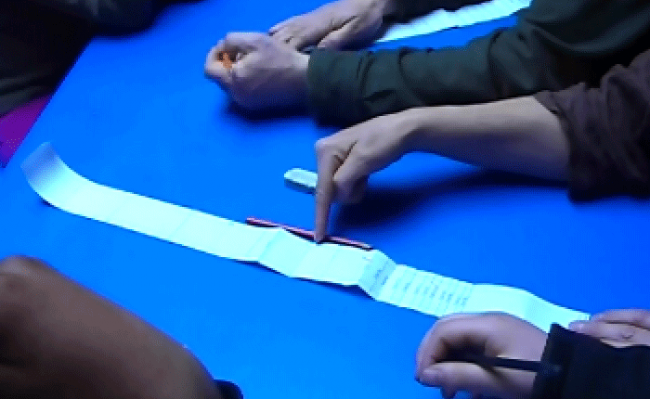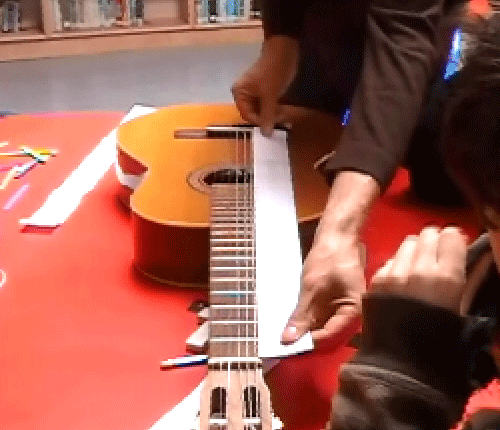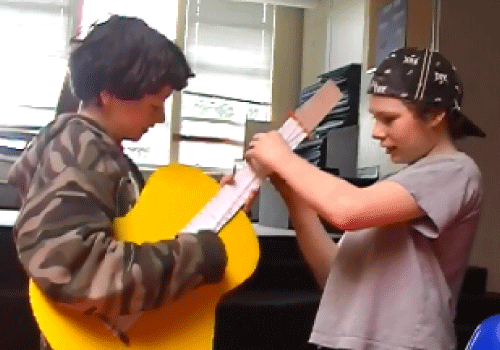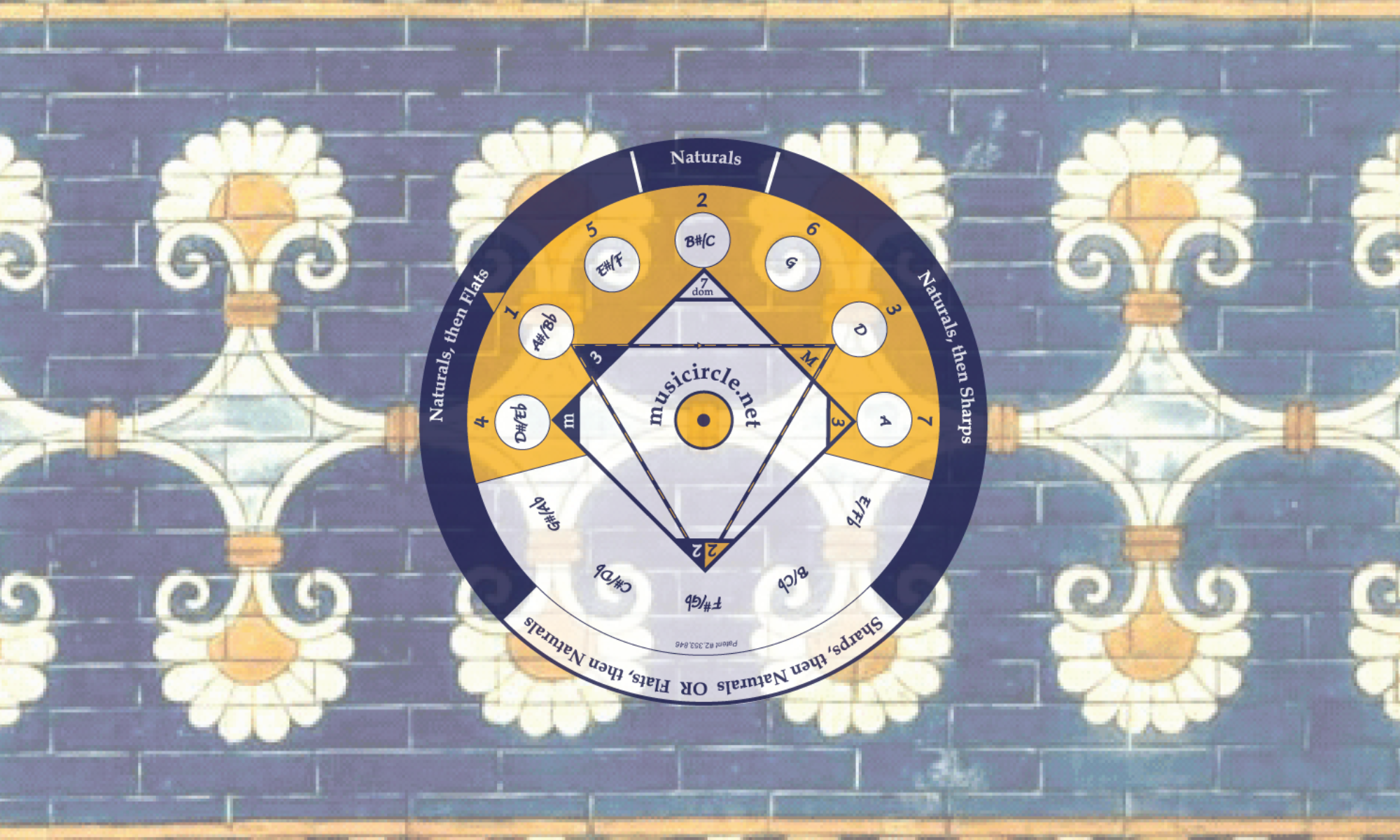
This page shows you how to derive the sequence 4,1,5,2,6,3,7 (which is written on Mesopotamian tablet CBS 1766) when creating a twelve-tone scale from perfect fifths using a process that was known, in ancient China, as the “up-and-down principle.”
Measuring against a guitar, each participant cuts a strip of paper that is the same length as one of the guitar’s strings. The paper is then folded exactly in half, and the fold line is emphasized with a red pencil and labelled “octave.” One end of the paper (either one) is now labelled “bridge” (see diagram below). The distance between the “octave” line and the end of the paper not labelled “bridge” defines the first octave: the space into which all twelve fifths will be moved.
The entire paper is now folded into thirds, generating two additional fold lines. The line that lies between the “octave” line and the end of the paper not labelled “bridge” is now darkened with pencil. On the right hand side of this (and all other selected fold lines), a running tally is kept of the number of times a “three-fold” has been made. Because this is the first three-fold, the number 1 is written on the right hand side of the fold line, like this: 1. This fold line is shown in the diagram below, colored in green. If the whole string were to sound the note C, then the length from the bridge to the fold line 1 (i.e. 2/3 of the whole string) would sound the note G: the fifth of C.
Now, the length of paper that lies between the bridge and the fold line 1 is folded in thirds. Two new fold lines appear. The one that lies closest to the fold line 1 is darkened with pencil and labelled 2 , because this is the second “three-fold”. This fold line (which is located at 2/3 of the distance from the bridge to the line labelled “1”) is shown in the diagram below, colored in yellow.

The fold line labeled 2 is not between the bridge and the red octave line. In other words, this note is not in the 1st octave. In order to move this note (the fifth of G: D) into the first octave its string length must be doubled. To accomplish this, the length of paper between the bridge and the fold line 2 is folded back over the strip of paper. Where the end of this length falls, a line is drawn. This drawn line is in the 1st octave.
On the left hand side of each drawn line, a running tally is now kept of the number of doublings made. For example, the pencil line just drawn is labeled with the number 1 on the left hand side because this was the first doubling. The number 2 is written on the right hand side of this line because no further three-folds were made: 1 2. This fold line is shown in the diagram below, colored in orange.
Notice that the line 2 is half the length of the line 1 2, when measured from the bridge, indicating that these two lengths of paper represent octaves of the same note: D. This is illustrated by the two horizontal arrows under the diagram below.
Now the length of paper that lies between the bridge and the line 1 2 is folded in thirds. Two new fold lines appear. The one that lies closest to the line 1 2 is darkened and labelled 1 3 , because this is the third “three-fold”. This fold line is shown in the diagram below, colored in pink.
Since this fold line lies within the 1st octave, there is no need for a doubling. Therefore, the next fifth is now generated by folding the length of paper that lies between the bridge and the fold line 1 3 into thirds.

The fold line that lies closest to the line 1 3 is now darkened and labelled 1 4. This fold line is shown in the diagram below, colored in blue.
Because this line is not in the 1st octave, a doubling is required. This generates the line 2 4, shown in the diagram below colored in brown.
This process is continued until the 12th fifth, C, is reached. This 12th fifth will fall very close to, but not exactly on, the red octave line. In fact, all the fold lines will differ slightly from the fret placements on the guitar, illustrating the difference between Pythagorean Tuning (represented by the fold lines generated by this exercise) and Equal Temperament (represented by the frets on the guitar).
The lines on the paper are now labelled with the notes of the chromatic scale, as shown in the diagram below. (In the diagram, the whole string is assumed to play the note C.) Now, using the numbers on the right hand side of the paper, make a list of which note names appear next to numbers 1 through 13. For example, in the diagram below, G is on the line with 1 in the right hand column, D is on the line with 2 in the right hand column, etc… Now look at the order of the notes. They are arranged in the circle of fifths: G, D, A, E, B…
Now look at the numbers on the left hand side of the paper: 4,1,5,2,6,3, _ , 4,1,5,2,6,3, _ , 4,1,5,2,6,3, _ ,…This is the sequence that orders the days of the week and selects the notes in a major scale from the circle of fifths. Notice, however, that the number 7 is not present. Here’s where it comes from:
Notice that the 13th fifth, G is labelled 6___________13. If we were to calculate the string length of the 1st fifth, G (shown in the diagram below by the line 1) by doubling the length from the bridge to the line 6___________13, we would label the 1st fifth 7________13 instead of ________ 1. If we follow the same reasoning for every new fifth ( D, the 14th fifth, A, the 15th fifth, etc… ) the number 7 appears in every blank spot in the left hand column. In other words, the sequence 4,1,5,2,6,3,7 is generated when all fifths are moved into the 1st octave from above.

This exercise is part of the workshop Music, Math, Archaeology. For more information about workshops, click here.
